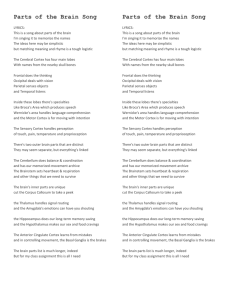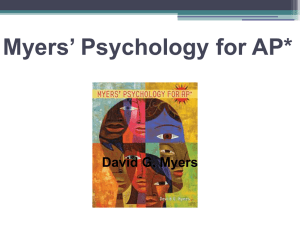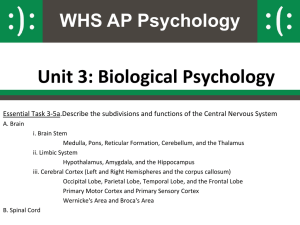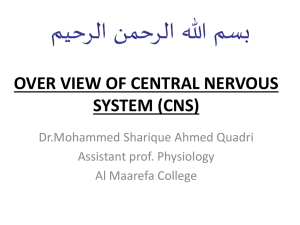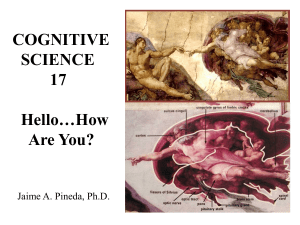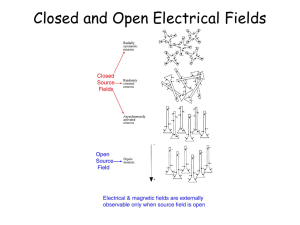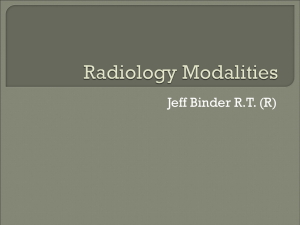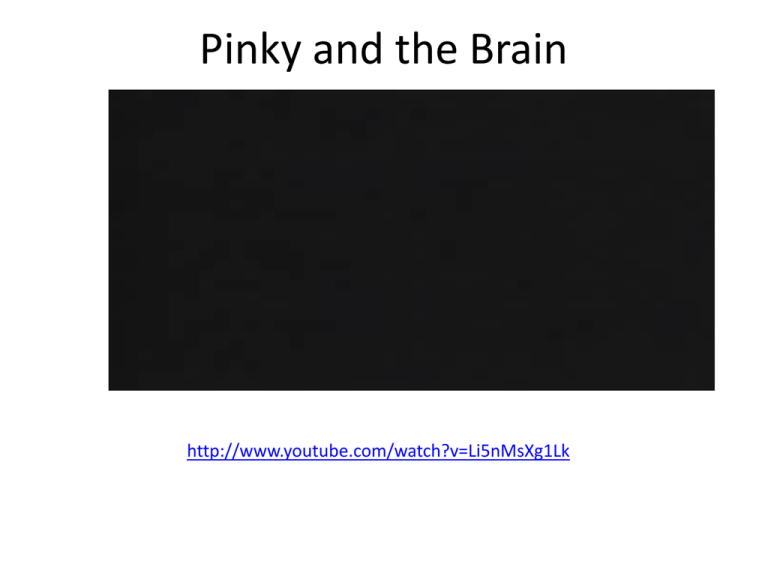
Pinky and the Brain
http://www.youtube.com/watch?v=Li5nMsXg1Lk
Dopamine Pathways
Serotonin Pathways
Medulla Oblongata
• Located just
above the spinal
cord.
• Involved in control
of
– blood pressure
– heart rate
– breathing.
Cerebellum
Fine muscle movements.
Coordination of
movements and balance
Reticular Formation
• Controls arousal and
ability to focus our
attention.
If stimulated
If Destroyed
Pons
• Contributes
to sleep and
arousal
Pons
Sleep and Arousal
Fac
Thalamus
• Switchboard of the
brain.
• Receives sensory
signals from the
spinal cord and
sends them to other
parts of the
forebrain.
• Every sense except
smell.
The Limbic System
Hypothalamus
•
•
•
•
•
Controls and
regulates
Body temperature
Sexual Arousal
Hunger
Thirst
Endocrine System
(Fight or Flight)
Hippocampus
• Involved in the
processing and
storage of
memories.
Amygdala
• Involved in how
we process
memory.
• More involved
in volatile
emotions like
anger.
The emotion of anger has not
changed much throughout evolution.
Nucleus Accumbens
• A region in the frontal cortex that
directs motivation to seek rewards.
• The nucleus accumbens is activated
by anticipated or received awards
(i.e., monetary, chocolate).
The Cerebral Cortex
Frontal Lobes
• Abstract thought,
personality, decision making
• Contains Motor Cortex:
sends signals to our body
controlling muscle
movements.
• Contains Broca’s Area:
responsible for controlling
muscles that produce
speech.
• Damage to Broca’s Area is
called Broca’s Aphasia:
unable to make movements
to talk.
Parietal Lobes
• Contain Sensory Cortex: receives
incoming touch sensations from
rest of the body.
• Most of the Parietal Lobes are
made up of Association Areas.
Functions of the Cortex
The Motor Cortex is the area at the rear of the frontal lobes that
control voluntary movements. The Sensory Cortex (parietal cortex)
receives information from skin surface and sense organs.
Association Areas
More intelligent animals have increased
“uncommitted” or association areas of the
cortex.
Occipital Lobes
• Deals with
vision.
• Contains Visual
Cortex:
interprets
messages from
our eyes into
images we can
understand.
Temporal Lobes
• Process sound sensed by
our ears.
• Interpreted in Auditory
Cortex.
• Contains Wernike's
Area: interprets written
and spoken speech.
• Wernike's Aphasia:
unable to understand
language: the syntax and
grammar jumbled.
Specialization and Integration in Language
Language Pathways
Broca's area and Wernicke's area are connected by a bundle of nerve fibers called the
arcuate fasciculus. Damage to the arcuate fasciculus causes a disorder called conduction
aphasia. People with conduction aphasia can understand language, but their speech does
not make sense and they cannot repeat words
Speaking the Written Word
To speak a word that is read, information must first get to the primary visual
cortex. From the primary visual cortex, information is transmitted to the
posterior speech area, including Wernicke's area. From Wernicke's area,
information travels to Broca's area, then to the Primary Motor Cortex.
Speaking the Heard Word
To speak a word that is heard, information must first get to the primary auditory cortex. From
the primary auditory cortex, information is transmitted to the posterior speech area, including
Wernicke's area. From Wernicke's area, information travels to Broca's area, then to the Primary
Motor Cortex.
Language
Aphasia is an impairment of language, usually caused by left
hemisphere damage either to Broca’s area (impaired speaking) or to
Wernicke’s area (impaired understanding).
Specialization & Integration
Brain activity when hearing, seeing, and speaking
words
Brain Activity when Hearing, Seeing, and
Speaking Words
Memorize the Parts of the Brain: Episode 72
of Psych Files
•
•
•
•
•
•
http://www.thepsychfiles.com/2008/09/episode-72-video-memorize-the-parts-ofthe-brain/
Cerebral Cortex: imagine a Texas cowboy hat on top of a brain. The cortex is the outer
layer of the brain just under the hat where complex thinking occurs.
Corpus Callosum: The corpus callosum is the fibers that connect the two halves of the
brain. Thus, it adds the two parts together. Think of the corPLUS CalloSUM. Since the
corpus callosum coordinates communication between the two hemispheres, think of
corpus Call Someone.
Thalamus: the thalamus takes sensations that come from the body and directs them to
the appropriate part of the brain for processing. Thus, think of Hal and Amos – two
traffic cops in the brain who direct these sensations to the right route.
Hypothalamus: the hypothalamus regulates a number of things in the body such as
body temperature, thirst, hunger, and sex drive. Think of “hypo the llamas”. Your llamas
are hot, sweaty and thirsty and you use a hypo to spray water on them to cool them
down and give them some water.
Hippocampus: the hippocampus is the seat of memory. Think of a hippo with a
compass. The hippo uses the compass to find his way back to the swamp because he
can’t remember where it is.
Memorize the Parts of the Brain: Episode
72 of Psych Files
• Amygdala: the amygdala controls your sense of fear. Think of either a MIG
coming right at you and, of course, making you afraid, or picture a scary wig
with dollars in it
• Pons: the pons helps you relax and sleep. Think of a relaxing pond.
• Cerebellum: the cerebellum helps in coordination and balance. Picture your
favorite athlete with bells all over his/her body (hanging from his/her
clothes, hands, feet, etc.).
• Reticular Formation: the reticular formation helps you to become alert and
aroused when you need to be. Think of what would happen if you were
napping and someone tickled you: your reticular formation would kick into
gear to wake you up.
• Medulla: the medulla regulates the autonomic activity of your heart and
lungs. Picture medals over your heart and lungs, or stick those medals into a
heart.
Pg 174-176 Answer Key
1.
2.
3.
4.
5.
6.
7.
8.
9.
10.
11.
12.
13.
14.
Reticular Formation – wakefulness and arousal
Cerebellum – coordination and balance
Frontal lobe – decision making
Hippocampus – memory
Amygdala – anger, emotion
Hypothalamus – regulating temperature, hunger, thirst, and sex
Medulla – heart rate, blood pressure, breathing
Motor cortex – voluntary movement (so doesn’t really apply to a
reflex like in this example; bad example) Better answer may be
sensory cortex
Hypothalamus – regulating temperature, hunger, thirst, and sex
Sensory cortex – sense of touch
Temporal lobe – hearing
Thalamus – sensory switchboard, except for sense of smell
Pituitary gland – produces hormones in charge of growth, thyroid
activity, puberty (production of testosterone/estrogen)
Occipital lobe - vision
(pgs 177-178 Case #1)
Anne the landscape artist is standing at her easel, painting with her right hand
as she looks out the window at her garden. She’s listening to classical music
as she paints.
Anne’s motor cortex is operating because she is moving her arm to paint.
Then ask the class whether the left or the right motor cortex is activated when
Anne moves her right arm. Also, I can ask the class in which lobe the motor
cortex I located.
Left motor cortex in the left frontal lobe = controls right hand
Visual cortex in both occipital lobes = used for vision
Auditory cortexes in both temporal lobes = used for hearing music
Right hemisphere = spatial ability for painting
Thalamus = relays sensory information. Relays visual and auditory cues while
painting to areas of the cerebrum.
Frontal lobes = deciding what to paint
Left sensory cortex in the left parietal lobe = feeling the paintbrush
Cerebellum = coordinates moving arm
(pgs 176-177 Case #2)
Crazy Eddie, the professional wrestler, is in the ring wrestling. The crowd is yelling and his opponent is taunting
him. Eddie yells back at his opponent. The two of them are out of breath and sweating profusely. They
continue their well-orchestrated series of wrestling moves.
Aceytlcholine is causing muscle contractions in Eddie and that endorphines are helping him to deal with the
pain involved.
Using his sensory cortex because he is relying on his sense of touch to wrestle his opponents. Ask whether he is
using the sensory cortex in his right or his left hemisphere, both hemispheres are operating.
Both motor cortexes in the frontal lobes = move muscles
Both sensory cortexes in parietal lobes = needed for sense of touch
Visual cortexes in both occipital lobes = used for vision
Auditory cortexes in both temporal lobes = processes sounds
Right hemisphere = spatial ability for wrestling
Wernicke’s area in left temporal lobe = understanding taunts and yells
Broca’s area in left frontal lobe = producing speech (yells)
Thalamus = relays sensory information.
Frontal lobes = decision making and attention
Medulla = regulates heart and breathing
Amygdala = aggression and fear controls arousal
Cerebellum = balance and coordination. Coordinates wrestling moves.
Hypothalamus = regulates temperature
Hippocampus = memory for moves
Pons = assists in the coordination of wrestling moves and in alertness.
Corpus Callosum = shares sensory and motor information from both hemispheres.
(pgs 176-177 Case #3)
Jill is a law student studying for her exam. She is reading about violent
murder cases. She is snacking on popcorn and drinking coffee.
Hippocampus = remembering and learning
Wernicke’s area in left temporal lobe = language comprehension
Amygdala = anger and fear about the cases
Frontal lobes = decision making and attention
Hypothalamus = regulate hunger and thirst. Makes us aware when we are too
hot or cold (to adjust the temperature controls) or too hungry, thirsty, or in
need of a restroom break.
Angular gyrus = needed for reading. Converts words into auditory code.
Reticular formation = regulates our alertness or drowsiness as we study (what
action do you take to keep alert while studying? Play music, take caffeine)


